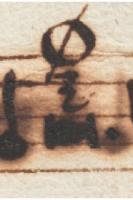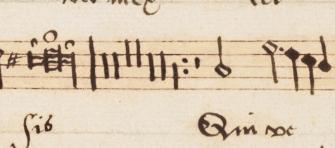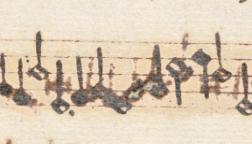News Archive
Restoring John Sadler's Partbooks: A Volunteer's View
 I'm a volunteer, and a novice one at that, on the digital restoration of John Sadler's partbooks. Volunteers bring a quirky variety of experiences to the process; in my case next to no practice in reading facsimile manuscripts, some playing experience of Tudor music and a fair track record of using Photoshop to improve photographs. So the first thing volunteers might look for is a way of filling in their skill gaps. In my case that would include knowing what symbols the writer uses and what they mean. The sundial/ spider's kneecap/ boiled sweet combo in the example here is fairly clear, despite the bleed-through from the next page, but I don't know how to interpret it.
I'm a volunteer, and a novice one at that, on the digital restoration of John Sadler's partbooks. Volunteers bring a quirky variety of experiences to the process; in my case next to no practice in reading facsimile manuscripts, some playing experience of Tudor music and a fair track record of using Photoshop to improve photographs. So the first thing volunteers might look for is a way of filling in their skill gaps. In my case that would include knowing what symbols the writer uses and what they mean. The sundial/ spider's kneecap/ boiled sweet combo in the example here is fairly clear, despite the bleed-through from the next page, but I don't know how to interpret it.

Ditto the 16th-century emoticon in the second example. Wikipedia has some useful material, but I haven't yet found a comprehensive guide to handwritten signs - perhaps there isn't one.
Armed with some rapidly-acquired knowhow, volunteers then embark on cleaning up a real page. Here's where the learning about the 'house style' takes place, specifically about how far to take the sanitising process. Adobe Photoshop is a wonderful tool, and it's so easy to get carried away and overdo the tidying up. Knowing when to stop is a familiar problem for painters - Google claims over 21 million entries on the subject - and beginners are apt to go for the clean look, slowly learning to do less as our taste matures. I find it useful to revisit the written guidance periodically, and it would be helpful for volunteers and staff to meet occasionally with the aim of working towards a common standard.
 Third and perhaps most fundamental point for these notes is the dilemma of getting the notes right. Sometimes, where the ink has completely eaten away the paper as in the example, it's impossible to be sure about even the most basic points - should this be a black note or a white note? Does this blob signify a dotted note or is it a bleed-through from the other side of the page, or just a mark on the paper? I've found that playing the line clears up some of the more obvious ambiguities, and I wonder if there is scope to sing or play all the parts together as we progress. Some of my guesses must be wrong, and a play-through would show up at least some of the mistakes in interpretation and allow us to correct the manuscript before it gets into print.
Third and perhaps most fundamental point for these notes is the dilemma of getting the notes right. Sometimes, where the ink has completely eaten away the paper as in the example, it's impossible to be sure about even the most basic points - should this be a black note or a white note? Does this blob signify a dotted note or is it a bleed-through from the other side of the page, or just a mark on the paper? I've found that playing the line clears up some of the more obvious ambiguities, and I wonder if there is scope to sing or play all the parts together as we progress. Some of my guesses must be wrong, and a play-through would show up at least some of the mistakes in interpretation and allow us to correct the manuscript before it gets into print.
So what is the experience like? It's new, interesting and challenging, and I'm enjoying the opportunity to be involved in something I would not otherwise have encountered. So far, anyway ...
Penny Aspden (Volunteer Restorer)
Find out more about John Sadler's partbooks.
Find out more about the restoration process and how to become a volunteer.
Last modified: Wed, 21 Oct 2015 13:25:01 BST


